Having the ability to change the start page in Task Manager is pretty useful. By default in Windows 11 the app opens to the Processes page. But you can change it say to Details that exposes more useful information about the apps. If you are using Task Manager frequently for managing the startup apps, you can always open to the corresponding tab instead.
Advertisеment
Windows 11 includes a brand new Task Manager app. It looks quite different from what you could see in previous OS releases. Besides the rounder corners and buttons, Windows 11 Task Manager sports a completely new layout.
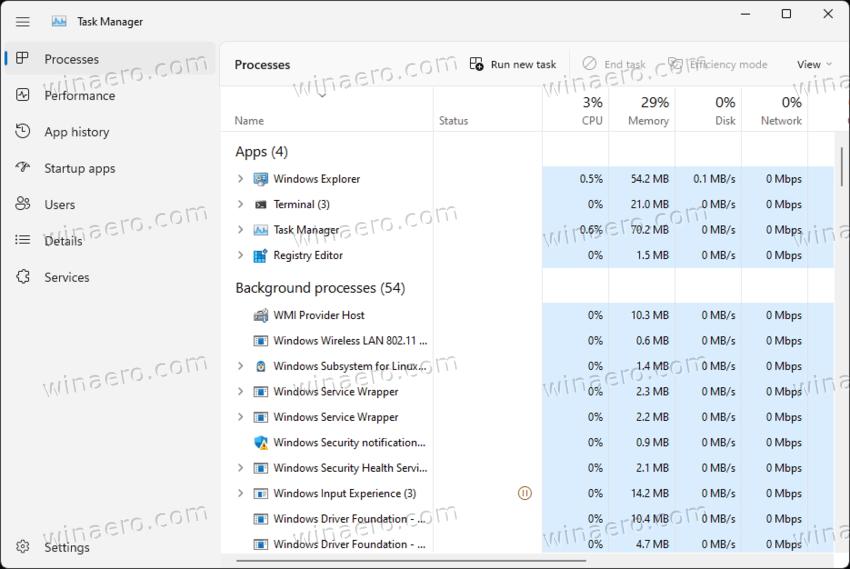
The tabs are now on the left, and are hidden by the hamburger menu. To see their names and expand the tabs, you need to click the menu button. Each its page now has their own set of buttons. E.g. for the process tab, you can run a new task, enable process groups, terminate the selected apps. On the Startup page you can enable or disable startup apps, open file properties or location, and so on.
In recent releases of Windows 11 it also draws the lines and highlights in the accent color you set in Personalization, that makes it beautiful. Also, the app support dark and light themes available in Windows.
Besides the cosmetic changes, it also adds a few more shortcuts to get things done faster. You can now use the Ctrl + Page Up and Ctrl + Page Down key combinations to switch between its pages. Also, pressing the Alt key on a page will reveal the accelerator keys to access the buttons directly.
For your convenience, you can change the startup page, e.g. to make it open to details instead of processes.
Change Start Page for Task Manager on Windows 11
- Press Ctrl + Shift + Esc keys to open the Task Manager app.
- Click on the "Settings" button (the gear icon) at the bottom left.
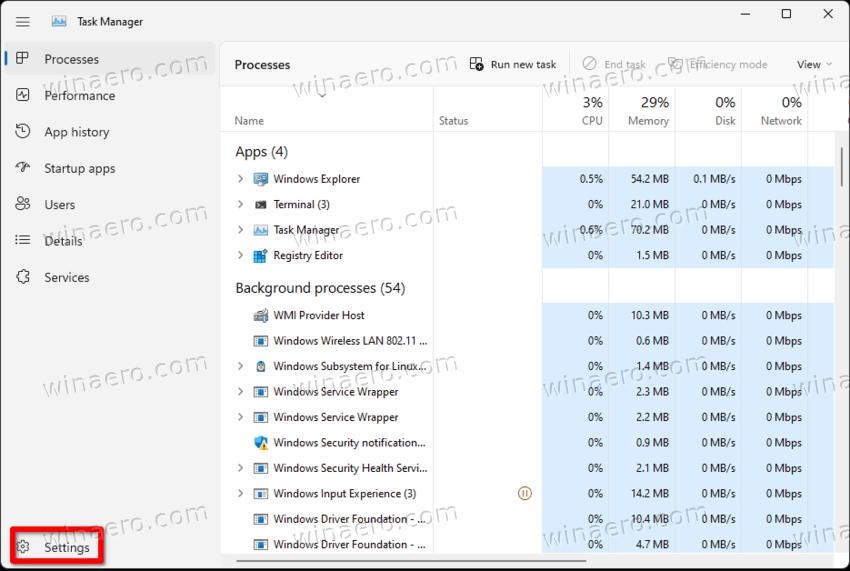
- On the settings page, select Processes, Performance, App history, Startup apps, Users, Details, or Services from the drop-down menu under Default Start Page.
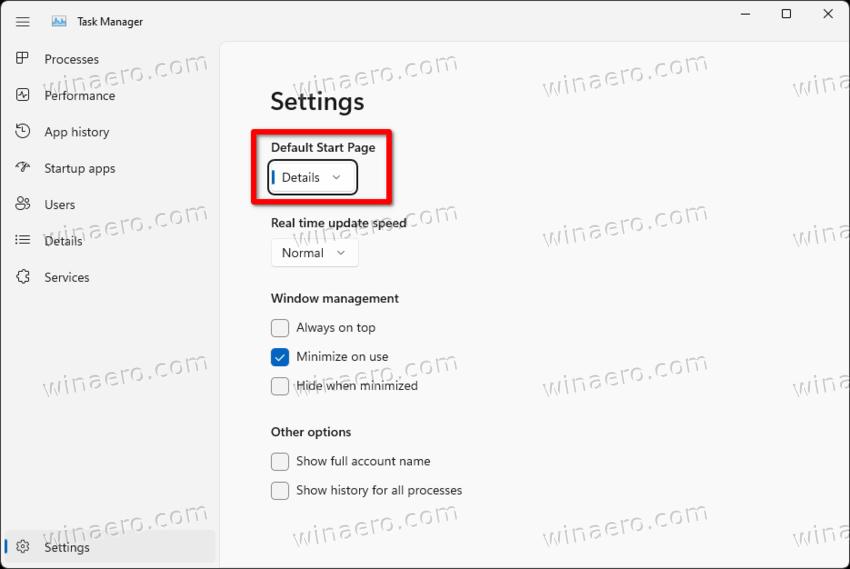
You are done. Next time you open the Task Manager, it will open to the selected start page.
Tip: If you are going to set the Task Manager to open the Startup page by default, I recommend you to create a special shortcut instead, or use a command. You can directly open the Startup page in the Task Manager by running it with the following arguments:
taskmgr /0 /startup
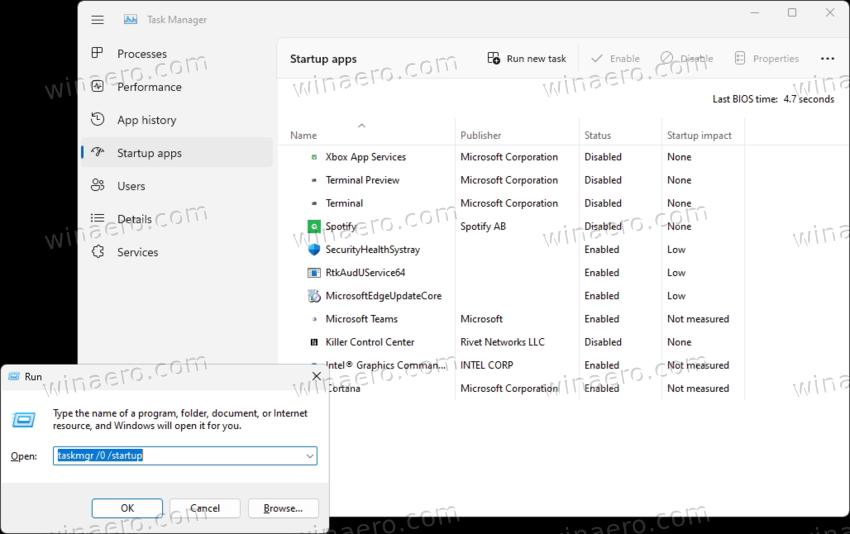
You can create a desktop shortcut with this command on desktop and manage startup app when needed. This command also works in Windows 10, so you can refer to the following guide to learn more about the desktop shortcut.
Available Tabs in Task Manager
Processes
The Processes tab displays a grid with running apps and background processes. For each of the processes, it shows CPU, RAM, disk, network, GPU, and other resource usage metrics.
Performance
On the Performance tab you will find several sections that include graphs for CPU, RAM, disk, network, and GPU resource usage. The graphs update in real-time, and also show extra info. For example, the Disk tabs show the drive type (SSD or HDD), the CPU page shows the model and clock for the processor, and so on.
App History
This tab shows how much hardware and network resources have been used by installed Store apps. By default Task Manager only lists the Store apps and UWP apps that come pre-installed. In its settings, you can make it show the history for all apps.
💡Click on the "Settings" gear icon at the bottom left, and place a checkmark for the "Show history for all processes" option to get all the apps listed on this tab.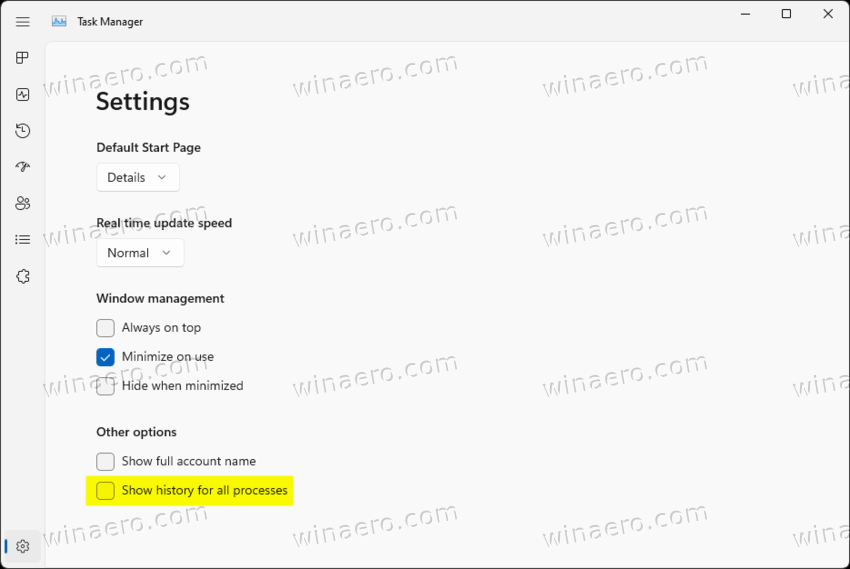
Startup apps
The Startup apps page lists the apps that start automatically with Windows. Here you can enable or disable specific entries to define what apps should start when you sign in to your user account.
Users
The Users tab of the Task Manager is a list of user account sessions on your PC. It displays the summary view of resources used by each user. By expanding the user row you will see the list of processes started by that user.
💡You can make the Task Manager show the full user name on this tab. In its settings, enable the option "Show full account name". After that, in addition to the user account name/email for Microsoft account it will also show the user's real name, surname and other details you could fill for your user account when created it.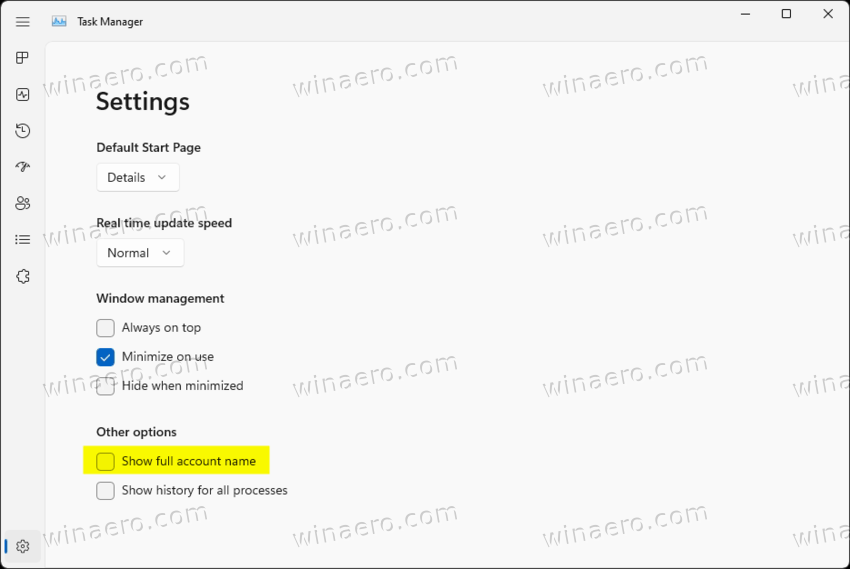
Details
This page is pretty similar to the first "Resources" tab, but it shows more details. It has a wider set of columns that you can hide or show. It doesn't support app groups and categories, i.e. it is a plain grid view. This page is similar to the Processes page of the classic Task Manager of Windows XP/Vista/7.
Services
Services is the last page of the Task Manager. It shows all the services registered in the operating system, and allows managing them from here. Specifically, you can start, stop and restart a service, and open the services.msc snap-in. You can also search online for the service name.
What you cannot do here is to configure service properties. For that, you must use the services.msc app.
Depending on your daily tasks, you can set any of the above pages as your startup tab in Task Manager, and it will save you a couple of clicks.
You may need to automate this process or apply the settings change to multiple computers. For that purpose, you can use a Registry tweak. The Task Manager stores your preferences under the HKEY_CURRENT_USER\Software\Microsoft\Windows\CurrentVersion\TaskManager key. The start page will be saved to the StartUpTab 32-bit DWORD value.
Update 2022/07/15: As of at least build 25151 of Windows 11 the Task Manager no longer uses the Registry key mentioned below. You can find what build and version of Windows 11 you have installed by running winver from the Run dialog (Win + R).
Set the default page for Task Manager in the Registry
- Press Win + R and type
regeditin the Run box. - Navigate to the HKEY_CURRENT_USER\Software\Microsoft\Windows\CurrentVersion\TaskManager path.
- In the right pane of the TaskManager folder change the StartUpTab value to one of the following numbers.
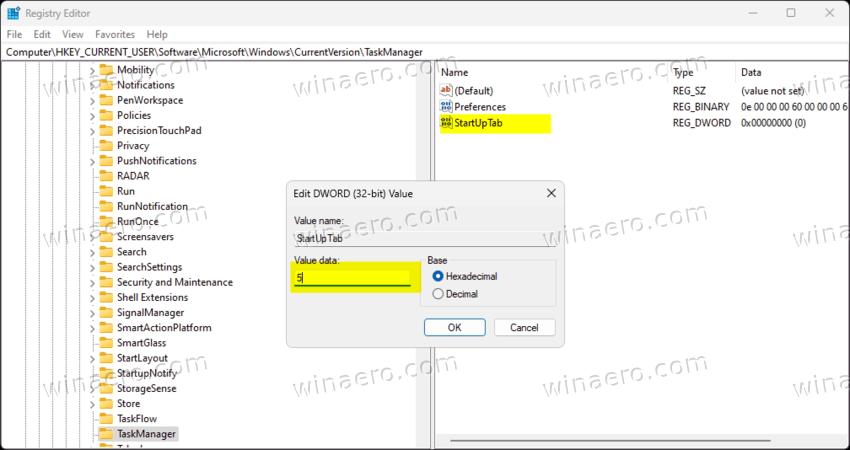
- StartUpTab = 0 - open Task Manager to Processes. This is the default value.
- StartUpTab = 1 - Set Performance as the default page.
- StartUpTab = 2 - Open App history by default.
- StartUpTab = 3 - Open Startup apps by default.
- StartUpTab = 4 - Task Manager will open Users.
- StartUpTab = 5 - Task Manager will open Details.
- StartUpTab = 6 - Make Services the default page.
- Now you can close the Registry editor and open the Task Manager to see the change.
For your automation tasks you would probably prefer either a console REG command to modify the Registry, or ready-made REG files.
Command prompt method
Open the command prompt (Win + R > cmd.exe > Enter), and issue the following command:
reg add "HCKU\Software\Microsoft\Windows\CurrentVersion\TaskManager" /v StartUpTab /t REG_DWORD /d <NUMBER> /f
Substitute the <NUMBER> portion with a value from 0 to 5 as described above. E.g. the next command sets the Details page as the default page.
reg add "HCKU\Software\Microsoft\Windows\CurrentVersion\TaskManager" /v StartUpTab /t REG_DWORD /d 4 /f

Finally, here are the REG files.
Download REG files
Click this link to download 7 files in a zip archive. Extract it to any folder convenient to you.
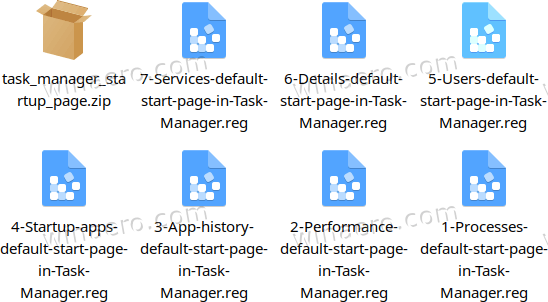
Click on one of the following files, and click Yes in the User Account Control prompt if you see it.
-
1-Processes-default-start-page-in-Task-Manager.reg, -
2-Performance-default-start-page-in-Task-Manager.reg, -
3-App-history-default-start-page-in-Task-Manager.reg, -
4-Startup-apps-default-start-page-in-Task-Manager.reg, -
5-Users-default-start-page-in-Task-Manager.reg, -
6-Details-default-start-page-in-Task-Manager.reg, 7-Services-default-start-page-in-Task-Manager.reg
The file names are self-explanatory, so simply pick the one that makes the tab of your choice the default start page in Task Manager on Windows 11.
After you confirm the Registry modification operation, you can safely delete the REG files, as they no longer needed for the Task Manager functions.
That's it.
Support us
Winaero greatly relies on your support. You can help the site keep bringing you interesting and useful content and software by using these options:

Hi @Sergey, I have another question related with the new Task Manager. Is there any way to set dark theme for Task Manager but without setting up default apps mode to dark in system settings? Other apps like Notepad or Calc can do this, unfortunately the Task Manager don’t have this setting.
Hi sir,
It doesn’t have a dedicated option for the dark theme.